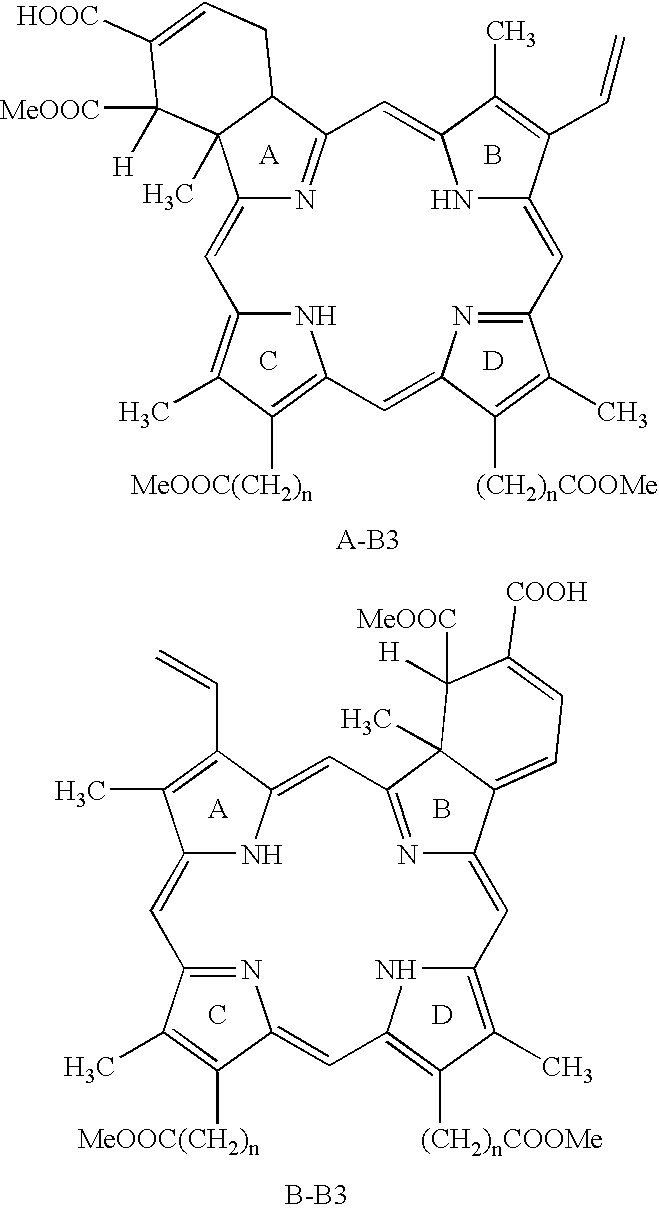Treatment of macular edema
- Summary
- Abstract
- Description
- Claims
- Application Information
AI Technical Summary
Benefits of technology
Problems solved by technology
Method used
Image
Examples
example 1
Treatment of DME with PDT
[0091]Patients having type I or type II diabetes mellitus are examined for the presence of lesions in the eye indicative of DME with diffuse lesions. Macular / retina edema is detected by slit lamp biomicroscopy, which detects retinal thickening. Patients are evaluated by fluorescein angiography within 7 days of treatment to determine the area of leakage in the macular / retina area. Patients are chosen who have evidence of diffuse macular / retina edema with fluorescein angiography leaking within 300–500 micrometers of the central area. Those determined as qualified for treatment of DME are divided into 6 groups. Groups A, B and C are treated with a regimen in which they are administered 6 mg / M2 (of body surface area) with Verteporfin for Injection (Visudyne™, Novartis Ophthalmics) in a 5% dextrose solution in a total volume of 30 ml. Administration is by intravenous infusion over a period of 10 minutes. Groups D, E and F are administered 30 ml of a 5% dextrose s...
example 2
Treatment of DME using a Photic Injury Model in the Monkey
[0092]The following model can be used to determine the effective dosages of a particular photosensitive compounds by replacing verteporfin with the test compound in the protocol. The model is a photic injury model in the rhesus monkey. The pupils of the monkey eye are dilated with 10% phenylephrine hydrochloride and 1% atropine (two drops per eye). An indirect ophthalmoscope (American Optical), set at 7.5 volts with a General Electric 1460 bulb, is placed 10 inches from a 20 diopter-condensing lens situated 2¼ inches from the cornea. The light is focused on the posterior pole of the retina. The beam power is 0.11 watts, measured by a radiometer at the cornea, and is calculated to give a retinal intensity of about 200 mW / cm2. The retina is then exposed to the light for 1½ hours (Tso et al. 1983 Ophthalmology 90: 952–963). Twenty-four hours after photic-injury induction, verteporfin is infused intravenously for 10 minutes at a ...
example 3
Treatment of DME in a Rat Model with Verteporfin
[0093]The following model can be used to determine the effective dosages for conducting PDT with photosensitive compounds other than verteporfin by substituting the compound to be tested in the protocol. The model is a Streptozotocin-induced diabetes model in the rat. Long-Evans rats weighing approximately 200 g receive a single 60 mg / kg injection of Streptozotocin (Sigma) in 10 mM citrate buffer (pH 4.5) after an overnight fast. Animals with blood glucose levels greater than 250 mg / dl 24 h later are considered diabetic. Blood pressure is measured by using a noninvasive cuff sensor and monitoring system (Ueda Electronics, Tokyo). Blood treated with the anticoagulant EDTA is drawn from the abdominal aorta of each animal after the experiment. The blood sample is analyzed with a hematology analyzer (Miyamoto K, et al. 1999 Proc. Natl. Acad. Sci USA: 96:10836–41.)
[0094]Seven days after the development of diabetes, verteporfin is infused in...
PUM
| Property | Measurement | Unit |
|---|---|---|
| Diameter | aaaaa | aaaaa |
| Diameter | aaaaa | aaaaa |
| Volume | aaaaa | aaaaa |
Abstract
Description
Claims
Application Information
 Login to View More
Login to View More - R&D
- Intellectual Property
- Life Sciences
- Materials
- Tech Scout
- Unparalleled Data Quality
- Higher Quality Content
- 60% Fewer Hallucinations
Browse by: Latest US Patents, China's latest patents, Technical Efficacy Thesaurus, Application Domain, Technology Topic, Popular Technical Reports.
© 2025 PatSnap. All rights reserved.Legal|Privacy policy|Modern Slavery Act Transparency Statement|Sitemap|About US| Contact US: help@patsnap.com



